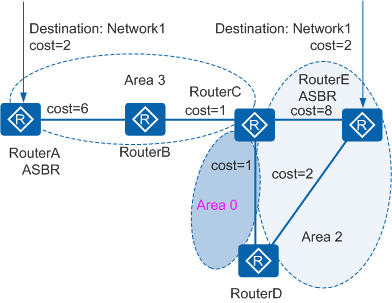OSPF TE
Traffic engineering (TE) requires knowledge of the network topology and network constraints, including the bandwidth, traffic engineering metrics, administrative groups, and affinity attributes. By itself, OSPF cannot meet these requirements and needs to be extended by introducing a new type of LSAs to advertise network constraints. Then, the Constrained Shortest Path First (CSPF) algorithm can calculate the path that satisfies defined constraints.
OSPF TE is designed to support MPLS TE and the establishment and maintenance of the Label Switch Path (LSP). In MPLS TE architecture, OSPF is responsible for collecting and advertising MPLS TE information.

OSPF Functions in MPLS TE Architecture
In MPLS TE architecture, OSPF advertises information by collecting and then flooding traffic engineering information to devices in the same area.
Collected information forms the traffic engineering database (TEDB) and is utilized by the CSPF to calculate routes.
OSPF does not consider what the specific information is or how MPLS uses the information.
TE-LSA
- Maximum link bandwidth
- Maximum reservable bandwidth
- Current reserved bandwidth
- Link color
Type 10 Opaque LSAs use OSPF flooding to synchronize link state information among devices in an area. This forms a uniform TEDB for route calculation.
Interaction Between OSPF TE and CSPF
OSPF uses Type 10 LSAs to collect traffic engineering information, including the bandwidth, priority, and link metric. OSPF then processes and provides the information for CSPF to calculate routes.
IGP Shortcut and Forwarding Adjacency
OSPF supports IGP shortcuts and forwarding adjacencies. These two features enable OSPF packets to reach a destination through a tunnel interface as the outbound interface. The differences between the two features are as follows:
Devices with IGP shortcuts enabled use a tunnel interface as an outbound interface without advertising the tunnel interface link to neighbors. This prevents other devices from using this tunnel. IGP shortcuts are unidirectional and need to be configured only on devices that need to use IGP shortcuts.
Devices with forwarding adjacencies enabled use a tunnel interface as an outbound interface while advertising the tunnel interface link to neighbors. This allows other devices to use this tunnel.
OSPF DS-TE
DiffServ Aware Traffic Engineering (DS-TE) combines the advantages of MPLS TE and Differentiated Services (DiffServ), and therefore it controls and forwards data differently based on Class of Service (CoS) while precisely controlling data paths. That is, DS-TE allows for efficient use of network resources while reserving required resources for different services.
To support DE-TE in MPLS, OSPF TE-LSAs contain local overbooking multiplier TLVs and bandwidth constraint (BC) TLVs. These TLVs are used to collect and advertise the information about the reservable bandwidth of each class type (CT) with a specific priority on the link. A class type refers to the bandwidth set of an LSP or a group of LSPs sharing the same CoS.
OSPF SRLG
OSPF supports Shared Risk Link Group (SRLG) applications in MPLS by obtaining information about the SRLG that floods traffic engineering information to devices in an area.